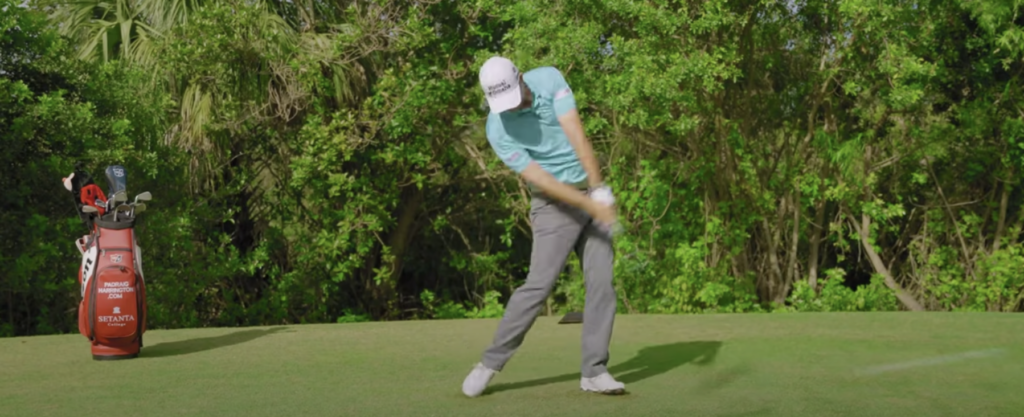As golfers, we’re always searching for that elusive combination of power and precision that can take our game to new heights. One of the holy grails of golf improvement is increasing our swing speed – that extra burst of velocity that can send the ball soaring down the fairway.
In a recent video, three-time major champion Padraig Harrington shared his wealth of knowledge on this very topic, debunking common myths and diving deep into the keys to unlocking explosive swing speed. Drawing from Harrington’s insightful “Paddy’s Golf Tip #13” on YouTube, this blog post will provide you with a comprehensive guide to boosting your clubhead speed and hitting the ball farther than ever before.
Whether you’re a weekend warrior looking to add some pop to your drives or a aspiring tour pro seeking that extra edge, the strategies outlined here can help take your game to new levels. So let’s dive in and unlock the secrets to generating more speed in your golf swing.

Debunking the Myth of the Long Backswing
One of the most prevalent misconceptions Harrington addresses is the idea that a longer backswing automatically leads to more clubhead speed. As he explains, “if your average force stays the same and you go for a longer time, basically you have a longer hand swing in the downswing, it means you have more speed.”
The Pitfalls of Overswinging
However, the reality is that many golfers, especially amateurs, struggle to maintain that consistent force through a longer backswing. Harrington notes that “when people swing longer because they’re not supple enough because they’re not fit enough, they make compensations.” These compensations often result in a loss of power and speed by the time the club reaches the ball.
The Optimal Backswing Length
Instead, Harrington recommends a shorter backswing for the majority of golfers, emphasizing that “your follow-through needs to be longer in order to maintain speed going through the downswing.” The key is finding the sweet spot – a backswing length that allows you to build sufficient tension and coil, without compromising your ability to accelerate the club through impact.
Mastering the Fundamentals of Speed Generation
Once you’ve dialed in the proper backswing length, Harrington delves into the core components of developing swing speed. He emphasizes that the wrists and arms play a pivotal role, accounting for up to 70% of your clubhead speed.
Activating the Wrists and Arms
“You’ve got to be active with your wrists,” Harrington advises. “You’ve got to be swinging your arms fast if you want to go fast.” This active wrist hinge and rapid arm swing are crucial for efficiently transferring energy through the club and out to the ball.
Coordinating the Body’s Movements
While the arms and wrists are the primary drivers of speed, Harrington cautions against allowing the body to dominate the swing. He explains that “for most amateurs, most handicapped golfers, they want to get their body to respond to their hands and arms” rather than the other way around.
By focusing on initiating the swing with the hands and arms, you can ensure that the body’s movements are in sync and supporting the speed generation, rather than working against it.

Unlocking the Power of Leg Drive and Ground Forces
Another key factor in increasing swing speed, according to Harrington, is the role of the lower body and ground forces. He emphasizes the importance of fully utilizing the legs and leveraging the ground to generate and transfer power.
Harnessing Leg Drive
Harrington advocates for actively lifting the left heel during the backswing, explaining that this small adjustment can provide an additional 2-4 mph of clubhead speed. “If everything stays the same, if you’re creating the same force by lifting your left heel higher, which means your hands get a little higher, you’ll gain two and a half inches of extra hand height, which is, I think, three to four miles an hour of speed.”
Optimizing Ground Forces
Complementing the leg drive, Harrington emphasizes the importance of properly utilizing the ground to generate and transfer power. He even uses specialized carbon fiber insoles in his shoes to enhance his ground force reactions, leading to an 8% improvement in clinical trials.
The key, as Harrington demonstrates, is to focus on driving the left side up and back during the backswing, while simultaneously pushing the right side down and through during the downswing. This coordinated lower body movement, combined with efficient ground reaction forces, is a hallmark of the world’s best power hitters.
Developing a Consistent Speed Routine
With the fundamental mechanics in place, Harrington emphasizes the importance of consistently working on increasing your swing speed. He recommends a weekly routine of speed-focused practice to maintain and improve your clubhead velocity over time.
Utilizing a Swing Speed Monitor
One of Harrington’s top tips is to invest in a simple swing speed monitor, which can be purchased for a few hundred dollars online. These devices allow you to measure your clubhead speed without the ball, providing valuable feedback on your progress.
Incorporating Speed-Focused Drills
Harrington suggests dedicating 20-30 swings per week to pure speed work, allowing yourself to “let it go” and swing as fast as possible. He also recommends incorporating drills like short, aggressive swings and two-handed throws to prime the body and build force.
By making speed development a regular part of your practice routine, you can ensure that your power and velocity remain at their peak, even as you get older and face the natural decline in physical abilities.

Embracing the X-Factor Stretch
One of the more nuanced and controversial topics Harrington addresses is the concept of the “X-factor stretch,” a term often associated with generating additional power in the golf swing.
Understanding the X-Factor Stretch
The X-factor stretch refers to the difference in the degree of rotation between the hips and the upper body at the top of the backswing. Harrington explains that while this separation can be beneficial, it’s crucial that the hips and torso remain connected throughout the swing.
The Importance of Connectivity
As Harrington states, “you don’t want to actually separate the two [hips and torso]; they have to stay connected.” The key is to maintain that stretch and tension through the transition, rather than allowing the hips to simply spin out independently. This connected X-factor stretch is what enables the powerful transfer of energy from the ground, through the body, and into the club.
By mastering this delicate balance of separation and connectivity, you can unlock an extra dimension of power and speed in your swing.
Conclusion
In the pursuit of greater distance and power in golf, increasing your swing speed is undoubtedly one of the most impactful areas of focus. Through the insightful guidance of Padraig Harrington, we’ve explored the myths, fundamentals, and specialized techniques that can help you unlock your explosive potential.
From debunking the long-held belief that a longer backswing equals more speed, to emphasizing the crucial role of the wrists, arms, and lower body, Harrington’s wisdom provides a comprehensive roadmap for golfers of all levels to boost their clubhead velocity.
Equally important is the need to develop a consistent speed-building routine, incorporating the use of swing speed monitors and targeted drills to ensure your power continues to evolve over time. And let’s not forget the nuanced concept of the X-factor stretch, where maintaining the connection between the hips and torso is key to channeling that energy effectively.
By implementing the strategies outlined in this blog post, you’ll be well on your way to unleashing your inner power and sending the ball soaring down the fairway like never before. So embrace these insights, put in the work, and get ready to experience the thrill of added distance and an explosive golf swing.
Leave a Reply